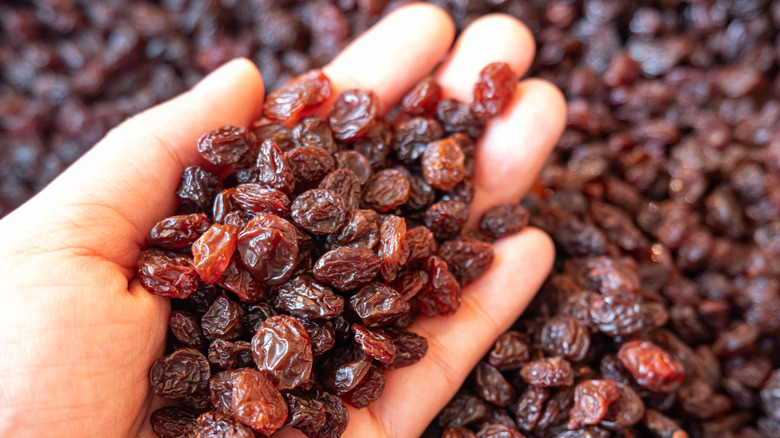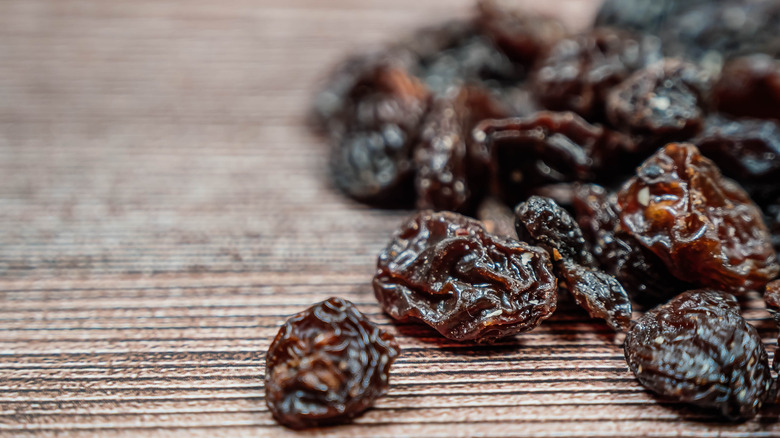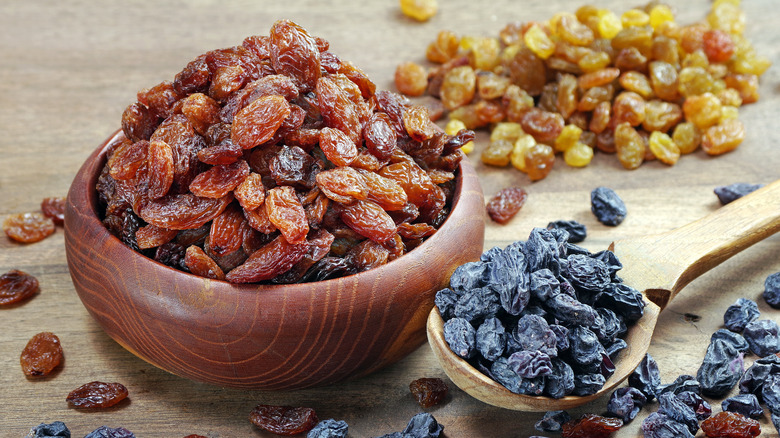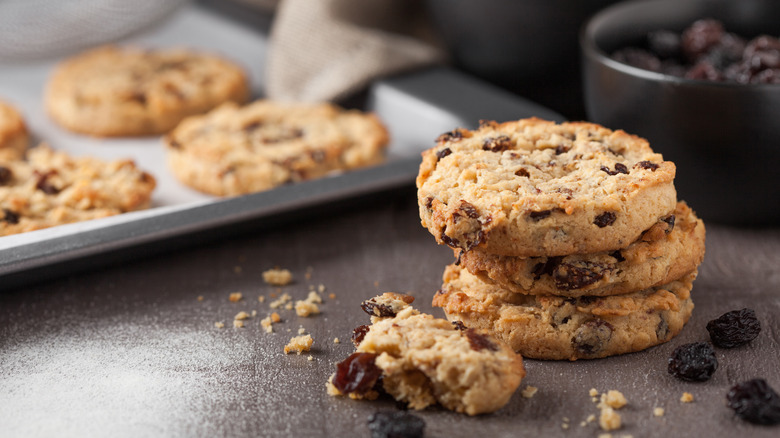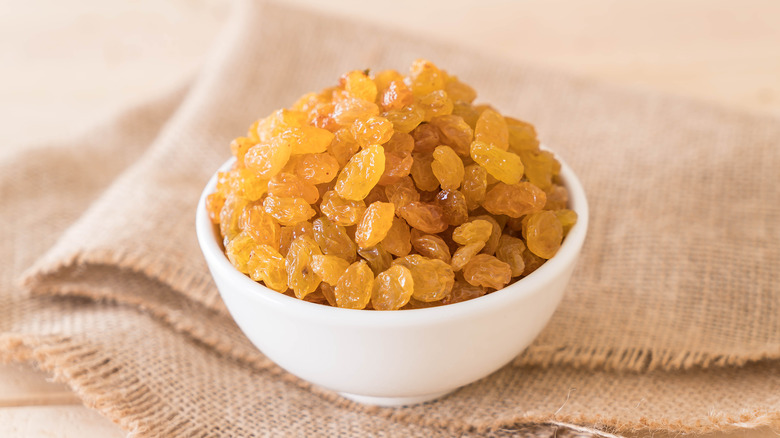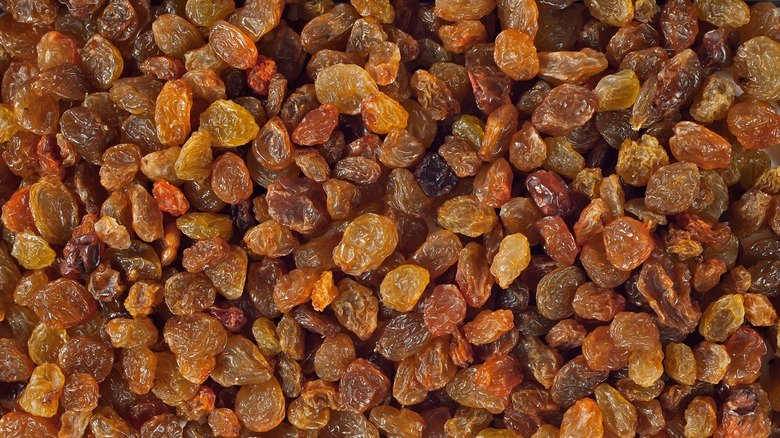What Are Raisins Really And Are They Nutritious?
If you have ever watched the "Great British Bake Off," you likely saw raisins in a lot of recipes. Being a staple in traditional British cakes, this comes as no surprise, per The Spruce Eats. In fact, raisins are added to many things. Just take this quote by Dorothy Parker: "This wasn't just a plain terrible, this was a fancy terrible. This was terrible with raisins in it."
The discovery of raisins was way back in 2000 BC, in what is known as ancient times. According to California Raisins, they happened to be stumbled upon dried up on vines. They eventually became so popular, you could give them out as prizes at sporting events and to trade with.
Even though it took several centuries for raisins to make an appearance in the United States, the country is now first place in production. In fact, California produces the most raisins in the entire world, per Britannica. It was the first state in the U.S. to actually grow grape vines specifically to produce raisins. So, what exactly is a raisin?
What are raisins?
Raisins come from grapes, Moscatel grapes to be exact (via The Spruce Eats). They are white-fleshed grapes that are green in skin color. If you want to get real technical, you can probably classify raisins as a fruit, since they come from one.
Moscatel grapes grow on a common vine known as Vitis vinifera, per California Raisins. They are seedless, which makes drying easier. The grapes typically stay in the sun during the process. It is common to use paper trays for drying, but sometimes they are just left on the vine until harvesting.
Once they have gone from grape to raisin (like a caterpillar to a butterfly), they are stored in wooden bins, picked off all stems, sorted by size, and then cleaned and washed (via California Raisins). The final product is a dark, dried, wrinkly fruit that is a lot smaller than the original grape.
What do they taste like?
Before you take a bite into a raisin for the first time, it is good to know they do not at all taste like grapes. Grapes are juicier, bigger, have a smooth skin on the outside, and not as sweet, per The Spruce Eats. The drying process concentrates the sugar in the fruit.
There are generally two types of raisins, golden and brown, and both have different flavor profiles. Golden raisins tend to be fruitier, whereas brown can be sweet and grainier, per Khoshbin Group. The drying process is the main reason brown raisins tend to be sweeter.
Golden are oven-dried and treated with sulfur dioxide, so they stay golden. Brown are typically dried in a vineyard for two to four weeks (via Khoshbin Group). Fun fact: Although they look and taste different, they come from the same kind of grapes — the green Thompson Seedless, says Epicurious.
How to cook with raisins?
The Spruce Eats says raisins are "one of the most versatile ingredients in the kitchen." Due to the fact that these wrinkly grapes can be eaten simply by themselves, in savory dishes, and desserts, it is not hard to agree. The best part? You don't have to "cook" them, instead you just toss them in!
The most prep you will do with raisins depends on what you are cooking. If you want to plump them up, simply soak them in water for 15 minutes. If you want to chop them up into smaller pieces, you can do that too (via The Spruce Eats). Pro tip: Dust the raisins in flower before putting in baked goods, so they don't sink to the bottom.
You can make raisin bread, chocolate covered raisins, or more advanced dishes like stuffing, cinnamon rolls, and plenty more. Since you can conveniently buy raisins at just about any store in the U.S., it is a pretty easy option to include in your next bake off.
Can you substitute raisins?
If you don't like raisins, but a recipe calls for them, what do you do? Well, the easiest and simplest option would be to exclude them. However, there are some other dried fruits you could take for a spin around the kitchen.
Raisins aren't everyone's cup of tea, so you can trade them out for things like currants or sultanas instead. It is good to know, though, that they won't offer the same flavor. But if you don't like the taste of raisins, that isn't necessarily a bad thing. Each offers their own special flavor into baked goods or dinner dishes.
Currants come from berries that grow on shrubs, rather than a vine like raisins. They are more sour in flavor, but still sweet. Think of when your mouth puckers when you eat Sour Patch Kids.
Sultanas are actually the golden raisins mentioned before. They come from the same grape and can be used in the same way as raisins, but are fruitier and smaller, says The Kitchn.
Are they nutritional?
Even though raisins are small, they pack a big bite of nutritional value. They have fibers, vitamins, and minerals in each little one, per Healthline. Tossing them in a salad, oatmeal, yogurt, granola, or cereal is a great way to add more nutrition into your diet.
However, with the positives come the negatives. Raisins are often referred to as "nature's candy." That is because they aren't exactly low in calories or sugar. In fact, half a cup of raisins has 217 calories and 47 grams of sugar. To give you an example, a typical soda has around 150 calories and 33 grams of sugar (via Healthline).
They do pack in a lot of fiber as well, with 3.3 grams in the same half a cup. Fiber, as most people know, helps your body digest better. You'll also get iron, copper, vitamin C, selenium, zinc, magnesium, and potassium, per Medical News Today.
